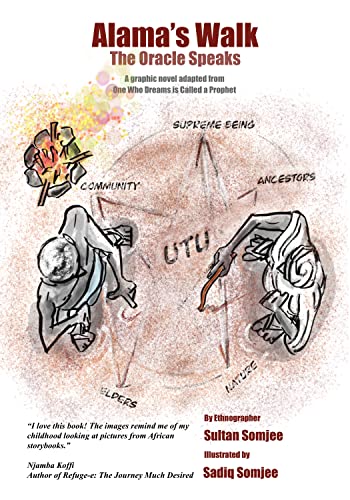‘The world belongs to the dreamer and doer
That lives within you and me
We build a better future when we are willing
To let our best ideas roam free
Today, the world is calling upon us
To activate our power
To dream differently.’- The World Dream Day, FaceBook
A Must-read Book

Photo:amazon
‘Alama, a nomad from the northern desert, sets out on a walk accompanied by Koko Kigongo, his walking stick. Along the journey, he meets women and men who are on a similar walk to find the Source of Peace. Like Alama, they are troubled by post-independence violence due to greed, misrule and corruption. Yet, the elders know that the Source of Peace lies in indigenous knowledge that lives in memories of every community of Yeta. But why can they not have peace? The dilemma confronts Alama. When they meet, the elders exchange their peace staffs and memories. Then they keep walking along their separate paths in quest for the Source of Peace.The imaginary walk of Alama is inspired by the author ethnographer Sultan Somjee’s journey. Initially, for two decades he worked on the material culture of Kenya and indigenous aesthetics. He introduced the study of African material culture into the school curriculum. Later, during the conflicts that plagued eastern Africa in the 1990s, Somjee looked towards communal practices of reconciliation for the next two decades. Using material culture, oral traditions, songs, dances, and his learning from Kamirithu Community Theatre and Educational Centre (1977), Somjee initiated the building of museums of peace with the participation of local communities. Museums of peace are grassroots civil societies that open spaces for communities to speak to each other about their heritages during conflicts and in-between when tensions arise due to political propaganda and sectarianism resulting in hate, humiliation and yearnings for revenge.’
Sultan Somjee-Photo: Daily Nation/Zera Somjee.
‘Sultan Somjee is a writer of unique quality. He has been honoured by the United Nations as an Unsung Hero of Dialogue Among Civilizations. His background as an ethnographer gives him ample material for his story lines. What makes him unique, however, is his insightful, poetic voice. His writing reaches deep into recesses in our being human. It awakens forgotten parts of our humanity, long hidden, covered up by lives immersed in acquisition, self-preservation, and egoistic endeavours. It refreshes the tired spirit, and opens doors to new visions of a better way to be. We taste what Alama seeks. This is Somjee’s art…a privilege to experience. Experience this wonderful adventure of discovery, and understand more.’...Read more
‘For four decades Sultan Somjee has worked on material culture. He introduced learning about indigeneity through material culture in the Kenyan school curriculum (1985-1990). While he was the Head of Ethnography at the National Museums of Kenya, Somjee started village peace museums. The museums highlight indigenous languages, material culture and the arts used over generations for reconciliation and social cohesion. Today, the peace museums have spread from Kenya to Uganda and South Sudan as a people to people civil society movement. In 2001, the United Nations named Dr. Somjee one among the only twelve ‘Unsung Heroes of Dialogue Among Civilizations’ worldwide in recognition of his work. In 2002, Dr. Somjee was appointed to the Global Advisory Board of Human Dignity and Humiliation Studies.
The book One Who Dreams is Called a Prophet is inspired by the author-ethnographer’s journey into the world of material culture, story telling, indigenous African knowledge and nature that describe Utu, Swahili for ‘being mtu’ or simply ‘being human’. All over traditional Africa the principle of Utu or Ubantu is used in reconciliation and sustaining peace.’
Reviews of “One Who Dreams is Called a Prophet”
Searching for Peace Within Kenya’s Warriors and between their Tribes, Review Essay, Michael Britton
‘Psychohistory, which postulates that both the unconscious and conscious shape history and are shaped by it, is the terrain on which this tale plays out. As in psychoanalysis, it is through the weaving together of conscious and unconscious minds that peace becomes possible; the world can change as it needs when peace is missing, and dreams can become decisive. A fourth generation Irish American myself, I learned a feel for the importance of dreams in difficult times from my father who had learned it from his father before him. I found in this book an affirmation of a tradition of dreaming not found elsewhere in my world today.’- in the Journal of Psychohistory
‘There is much to admire about Kenya’s Indigenous Peoples as peacemakers that are portrayed in One Who Dreams is Called a Prophet. In this creative fiction, Sultan Somjee intricately weaves together memoir, history, and peace heritage traditions by telling the story of one of the most sought-after ideals of humankind, the search for peace. Alama, the protagonist, walks across Kenya’s red soil meeting Elders, exchanging peace staffs, and with each encounter illuminating the stories of the beauty of peace. During his interactions with Western hegemony, he challenges liberal peace practices being employed and rejects money and fame, turning towards his own honour, dignity and freedom. Ultimately, finding internal peace within his own Indigenous belief system.”- Kimberly Baker, UBC Ph.D Candidate (Thesis: Museums of Peace in Conflict Zones), and Chair, The Living Peace Museum, Canada
‘At a time when the world experiences the seriousness of social and environmental unsustainability, One Who Dreams is Called a Prophet offers a perspective on the urgency of a radical socio-cultural transformation from an African vantage point. It reflects on the existential questions and devastating impacts caused by colonial regimes and the neo-patrimonial political systems that followed them on the Continent. And it does so with a brilliant narrative style, based on African cultural heritage, ranging from storytelling traditions to proverbs, parables and riddles layered in metaphors and satire.
One Who Dreams is Called a Prophet is a captivating reading, very entertaining, with an unpredictable plot and a vivid narrative that paints every scene as a microcosm that unfolds through rich sensorial renderings and spiritual insights. African readers will find inspiration in it, and a path to develop an appreciative and critical consciousness of their own cultural heritage as a gift for peace’. Alberto Parise, Comboni Missionary
Buy the book HERE
See also: Alama's Walk, The Oracle Speaks, the graphic novel is adapted from "One Who Dreams is Called a Prophet"

‘Alama's Walk , The Oracle Speaks, is the first of three graphic novels on heritage stories about Indigenous peace practices in eastern Africa. The three novels are from One Who Dreams is Called a Prophet, a book about a lone elder’s walk in pursuit of the last traces of Indigenous knowledge of Utu during conflicts. Utu in Swahili means the quality of being human or simply humanness or humanity. The walk resulted in cultivating conversations on reconciliation in a conflicted country, among diverse cultures, in diverse languages and diverse arts that led to the making of the Community Museums of Peace in eastern Africa.
The forthcoming two graphic novels, Alama's Walk, Healing the Earth (2022) and Alama's Walk, Ogres of Humiliation and Revenge (2023), similarly radiate grassroots narratives from the walking sticks carried by elders. The walking sticks are respected for they are often carved out of peace trees and used during reconciliation. Each book has a running meme on Utu as viewed by 10 Indigenous cultures through elders’ memories, the environment, material culture, community stories, rituals and spirituality.’
Alama's Walk - character designs based on the Turkana, Pokot and Borana people of East Africa: Watch the Video
Buy the book HERE
Dialogue, Friendship, Forgiveness and Reconciliation, Peace and Justice, Ubantu, I am because We Are
A pick from our GCGI archive

We can all imagine the world we want to build; now's the time to start its construction. -Photo: Via the BBC
GCGI is our journey of hope and the sweet fruit of a labour of love. It is free to access, and it is ad-free too. We spend hundreds of hours, volunteering our labour and time, spreading the word about what is good and what matters most. If you think that's a worthy mission, as we do—one with powerful leverage to make the world a better place—then, please consider offering your moral and spiritual support by joining our circle of friends, spreading the word about the GCGI and forwarding the website to all those who may be interested.
Let Us Dream: The Path to a Better Future
‘I have a Dream’, 57 Years On and Why We Must Carry on Imagining the Dream
Dreaming About Utopia to Make the World Great Again
‘I Have a Dream’: Yearning for Dr. King’s Interconnected World
Recalling an epoch-defining day: “I Have a Dream” speech remembered
A Must-read book on the “I Have a Dream” speech
Ubuntu Education: Nelson Mandela’s Lasting Legacy
The Spirit of Ubuntu and the Common Good
Celebrating the Centenary of the Man for the Common Good
The Road to Peace, Justice, Prosperity, Happiness and Well-being
The Anxious and Troubled Times: ‘Now we need books more than ever’
Compassion, kindness, hope, courage and joy: The Path to a More Loving World
Forgiveness and Reconciliation in Pursuit of the Global Common Good
